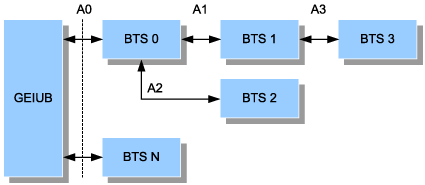This describes the BTS multiplexing modes. The BTS multiplexing in the BSC refers to the multiplexing of the LAPD signaling on the E1 timeslots of the Abis interface. The BSC offers six 64 kbit/s statistical multiplexing modes (n:1, n <= 6). They are 1:1, 2:1, 3:1, 4:1, 5:1, and 6:1. The BSC also offers the physical 16 kbit/s multiplexing mode.
All the BTSs except for the BTS20, BTS22C, BTS3001C, BTS3001C+, BTS3002C, BTS30, BTS312, BTS3012A, and BTS3006A support manual assignment of the multiplex timeslots.
In all the n:1 E1 timeslot multiplexing modes, the speech rate is 16 kbit/s or 8 kbit/s (half rate). Four speech channels (eight channels for half rate) occupy one 64 kbit/s timeslot on the Abis interface. The rate of all the signaling links is 64 kbit/s. In different multiplexing modes (n:1), n signaling timeslots occupy one E1 timeslot (64 kbit/s) on the Abis interface. All the timeslots perform the 64 kbit/s multiplexing on the GEIUB of the BSC.
In 16 kbit/s multiplexing mode, the data rate of all the multiplexed signaling links must be 16 kbit/s. The BTS20, BTS22, BTS3001C, and BTS3001C+ do not support the physical 16 kbit/s multiplexing mode.
One GEIUB of the BSC supports multiple BTS multiplexing modes. Because of the transparent transmission between cascaded BTSs, one E1 supports multiple multiplexing modes, as shown in Figure 1.
The four E1s are A0, A1, A2, and A3, as shown in Figure 1. If the multiplexing modes of BTS 0, BTS 1, BTS 2, and BTS 3 are 1:1, 2:1, 3:1, and 4:1, then four multiplexing modes exist on the GEIUB. The multiplexing mode of each E1 on the link where the BTS is located is subject to the multiplexing mode of the BTS itself.
- Four multiplexing modes exist on A0. They are 1:1, 2:1, 3:1, and 4:1.
- Two multiplexing modes exist on A1. They are 2:1 and 4:1.
- One multiplexing mode exists on A2. It is 3:1.
- One multiplexing mode exists on A3. It is 4:1.
